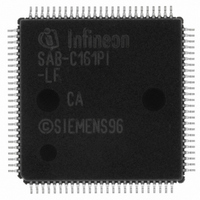SAB-C161PI-LF CA Infineon Technologies, SAB-C161PI-LF CA Datasheet - Page 20

SAB-C161PI-LF CA
Manufacturer Part Number
SAB-C161PI-LF CA
Description
IC MICROCONTROLLER 16BIT 100TQFP
Manufacturer
Infineon Technologies
Series
C16xxr
Datasheet
1.SAF-C161PI-LM_CA.pdf
(82 pages)
Specifications of SAB-C161PI-LF CA
Core Processor
C166
Core Size
16-Bit
Speed
20MHz
Connectivity
EBI/EMI, I²C, SPI, UART/USART
Peripherals
POR, PWM, WDT
Number Of I /o
76
Program Memory Type
ROMless
Ram Size
3K x 8
Voltage - Supply (vcc/vdd)
4.5 V ~ 5.5 V
Data Converters
A/D 4x10b
Oscillator Type
Internal
Operating Temperature
0°C ~ 70°C
Package / Case
100-LFQFP
Packages
PG-TQFP-100
Max Clock Frequency
20.0 MHz
Sram (incl. Cache)
3.0 KByte
A / D Input Lines (incl. Fadc)
4
Program Memory
0.0 KByte
Lead Free Status / RoHS Status
Lead free / RoHS Compliant
Eeprom Size
-
Program Memory Size
-
Other names
B161PILFCAXT
SAB-C161PI-LF CA
SAB-C161PI-LFCAINTR
SABC161PILFCAXT
SP000014344
SAB-C161PI-LF CA
SAB-C161PI-LFCAINTR
SABC161PILFCAXT
SP000014344
Data Sheet
Interrupt System
With an interrupt response time within a range from just 5 to 12 CPU clocks (in case of
internal program execution), the C161PI is capable of reacting very fast to the
occurrence of non-deterministic events.
The architecture of the C161PI supports several mechanisms for fast and flexible
response to service requests that can be generated from various sources internal or
external to the microcontroller. Any of these interrupt requests can be programmed to
being serviced by the Interrupt Controller or by the Peripheral Event Controller (PEC).
In contrast to a standard interrupt service where the current program execution is
suspended and a branch to the interrupt vector table is performed, just one cycle is
‘stolen’ from the current CPU activity to perform a PEC service. A PEC service implies a
single byte or word data transfer between any two memory locations with an additional
increment of either the PEC source or the destination pointer. An individual PEC transfer
counter is implicity decremented for each PEC service except when performing in the
continuous transfer mode. When this counter reaches zero, a standard interrupt is
performed to the corresponding source related vector location. PEC services are very
well suited, for example, for supporting the transmission or reception of blocks of data.
The C161PI has 8 PEC channels each of which offers such fast interrupt-driven data
transfer capabilities.
A separate control register which contains an interrupt request flag, an interrupt enable
flag and an interrupt priority bitfield exists for each of the possible interrupt sources. Via
its related register, each source can be programmed to one of sixteen interrupt priority
levels. Once having been accepted by the CPU, an interrupt service can only be
interrupted by a higher prioritized service request. For the standard interrupt processing,
each of the possible interrupt sources has a dedicated vector location.
Fast external interrupt inputs are provided to service external interrupts with high
precision requirements. These fast interrupt inputs feature programmable edge
detection (rising edge, falling edge or both edges).
Software interrupts are supported by means of the ‘TRAP’ instruction in combination with
an individual trap (interrupt) number.
The following table shows all of the possible C161PI interrupt sources and the
corresponding hardware-related interrupt flags, vectors, vector locations and trap
(interrupt) numbers.
Note: Interrupt nodes which are not used by associated peripherals, may be used to
generate software controlled interrupt requests by setting the respective interrupt
request bit (xIR).
18
&3,
1999-07












